The High Tie blackjack side bet (HT) dates back at least to 2004, where it is mentioned in this article. I recently ran into this bet at a casino I was visiting. After all these years, it’s still around. In fact, it is also part of the DigiDeal lineup. This wager pays when the player is dealt blackjacks and pairs, with bonuses for suited hands. At first, it may appear that this collection of unrelated elements would make the bet uncountable. But the fact that blackjacks are part of the pay table outweighs the other parts of the bet. Any card counting system that compares ten-valued cards and Aces against pip cards can be used to beat this side bet.
In considering this bet, we define a “High Tie” to be any hand when both the player and dealer both have blackjack. This outcome gives the top payout. All other payouts are based on the player’s hand alone. In this document from the State of Washington, a number of pay tables and versions are given. Rather than going through each possible pay table and version, I am going to present only the single-deck and double-deck pay tables in live-play at the casino mentioned above. Here is the combinatorial analysis:
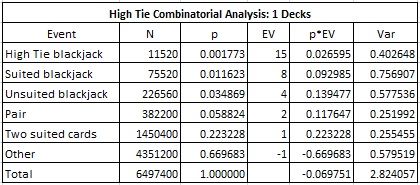
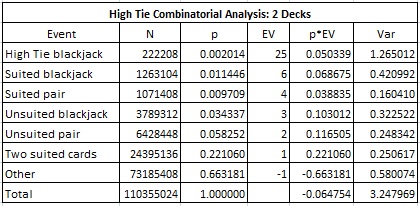
Note that the house edge for the two-deck version is 6.475%. This contradicts the house edge of 6.823% given in the Washington documentation. I puzzled over this until I realized that I could get the 6.823% number if I simply reversed the payouts for the suited blackjack and suited pair. When I re-did the combinatorial analysis with suited blackjack paying 4 and a suited pair paying 6, my results matched the documentation with a house edge of 6.823%. The question is then, which is right? Which of these two pay tables is on the floor of the casino? For the purpose of this study, I am going to use the pay table above, with a house edge of 6.475%, and assume the house edge given in the Washington documentation is wrong.
It is clear that HT is vulnerable to the standard High-Low card counting system (2,3,4,5,6 = +1, T,J,Q,K,A = -1), which I denote (-1,1,1,1,1,1,0,0,0,-1) given in the order (A, 2, 3, 4, 5, 6, 7, 8, 9, T). My first step was to quantify this vulnerability to get a baseline. The following table gives the results of using the High-Low count against HT. These results were obtained by a simulation of one hundred million (100,000,000) two-deck shoes, with the cut-card placed at 75 cards (29 from the end):
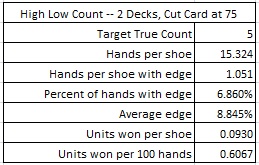
If the maximum bet is $100, and the AP is playing heads-up on a fast game, getting 200 rounds per hour, then the AP using the High-Low count will earn about $121 per hour from the HT.
Normally at this point of the analysis, I would compute the “effect of removal” of each card and use those numbers to generate an optimal count system. That is not necessary here. It is clear that removing the pip cards 2, 3, 4, 5, 6, 7, 8, 9 from the shoe moves the edge towards the player. Likewise, the cards T, J, Q, K, A are the ones that benefit the player side, so removing them moves the edge towards the house. The aces are at a special premium because of their necessity in getting blackjacks and their limited number compared to ten-valued cards. For these reasons, there is a natural balanced card counting system to try:
- 2, 3, 4, 5, 6, 7, 8, 9 = +1
- T, J, Q, K = -1
- A = -4.
I will refer to this as the "Blackjack count" and refer to it by the notation (-4,1,1,1,1,1,1,1,1,-1).
The following table gives the results of using the Blackjack count against HT. These results were obtained by a simulation of one hundred million (100,000,000) two-deck shoes, with the cut-card placed at 75 cards (29 from the end):
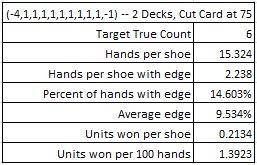
If the maximum bet is $100, and the AP is playing heads-up on a fast game, getting 200 rounds per hour, then the AP using the Blackjack count will earn about $278 per hour playing against the HT. The Blackjack count gives 130% more return than the High-Low system.
Next, I consider the single-deck version. The problem with a single-deck game is that it is usually dealt in a “rule-of-X” version. There is no fixed placement of the cut-card. Rather, the number of rounds depends on the number of players at the table. For example, “rule-of-6” means that five rounds are dealt between shuffles if there is one player, four rounds are dealt if there are two players; three rounds are dealt if there are three players, and so on. “Rule-of-X” means “rounds + players = X”.
The problem with the single-deck game is that the penetration is usually very shallow. In today’s environment, a “rule-of-5” game is the standard, along with the abusive rule “blackjack pays 6-to-5.” This combination is toxic for the advantage player who wants to beat the single-deck version.
Here are the numbers for the “rule-of-5” and “rule-of-6” single-deck games, based on simulations of one hundred million (100,000,000) decks each:
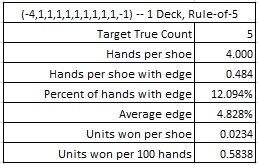
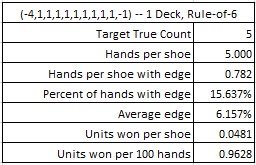
If the maximum bet is $100, and the AP is playing heads-up on a fast single-deck game, getting 200 rounds per hour, then the AP using the Blackjack count will earn about $193 per hour playing against the HT. However, this game will be on a 6-to-5 single-deck table and the house edge on the main game will take a significant bite out of that $193.
It is important for game protection to understand the sensitivity of HT to deck penetration. One of the easiest ways to protect HT is to deal fewer cards per shoe. The following table makes this clear:
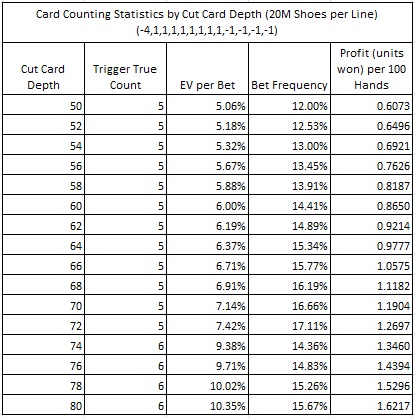
However, decreasing the penetration has its own costs, due to the greater time spent shuffling and the consequent decisions lost.
There is also a six-deck pay table for HT that I have not yet considered. As the analysis of several other side bets has shown, the greatest vulnerability usually occurs on the double-deck version.
Safeguarding the HT bet is urgent and critical for all casinos that offer this bet. This is a gaping hole and a lot of cash may be going out the door. The following are my recommendations for protecting HT:
- Watch for players who usually play HT late in the deck at a maximum bet.
- Decreasing penetration has a moderate effect in neutralizing AP opportunities. Set the shuffle point at 60 cards or less.
- Watch for the other tells of an ordinary card counter.
- Watch for team play.


